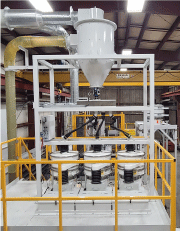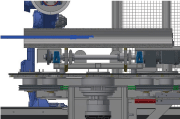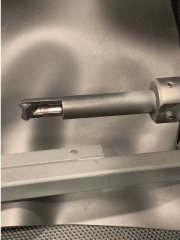E-Archive
Articles
in Vol. 22 - July Issue - Year 2021
Parallels in Shot Peening & Grit Blasting equipment

Picture shows a vacuum style media reclaim system to handle three different media sizes, with a diverter valve to divert it to one of the three classifiers for size classification


ID Lance with deflector tip commonly used for grit blasting part IDs
Introduction
Advanced manufacturing such as in the Automotive, Aerospace and Medical industries use shot peening and grit blasting for benefits related to enhancement of fatigue strength and generation of surface texture respectively. In these industries, particularly Aerospace and Medical, emphasis is placed on the consistency of surface finish across the topography of the component. This gets to be a challenge in parts with relatively complex geometry such as aircraft engine components and certain medical implants, necessitating the need for automated equipment with articulating nozzles. Where shot peening has a defined end-point in the form of a tangible value of intensity (usually within a range) and coverage (%), measures of surface finish in terms of Ra and Rz values validate grit blasting results. On a fundamental level, shot peening, grit blasting and blast cleaning can be explained with a single equation, 0.5 * mass * square of velocity. Commonly termed as ‘Impact Energy’, ‘Transmitted Energy’ or ‘Kinetic Energy’, this factor determines the nature of the surface that is going to be created after the particle of abrasive (peening or grit blasting media) has impacted the component.
In shot peening, this impact energy is responsible for creating a dent (compression) with the spherical cast shot or cut wire shot particle (glass bead or ceramic when peening with non-metallic media). The size of media (example: S70, S660, AWCR32 etc.) and the velocity with which it is propelled on to the part (speed of blast wheel or air pressure) determine the impact energy. The larger the shot particle, the higher the impact energy, resulting intensity, and vice-versa. In contrast, grit blasting leads to an etched or chiseled surface profile, largely because grit blast media is angular in shape with distinct sharp edges that create the etch. The mechanism of creating impact remains the same with steel shot as with non-metallic media, where air pressure and media size are directly proportional to the impact energy.
A closer look at the media propulsion techniques, media reclaim, and process control will reveal the similarities in both processes.
Equipment and process parallels
Choice of media dictates several facets of a shot peening and grit blasting machine. Shot peening is carried out with cast steel shot and cut wire shot for metallic peening media whereas grit blasting is almost always carried out with aluminium oxide (in some cases with Silicon Carbide). Metallic media can be propelled with blast nozzles as well as centrifugal blast wheels whereas aluminium oxide uses compressed air for propulsion purposes. Wheel-type shot-peening machines are more prevalent in the Automotive industry due to high production volumes and efficacy of wheelblast machines to propel greater amounts of media than their airblast counterparts. Given the focus of this discussion, it will be more pertinent to discuss similarities between grit blast machines and shot-peening machines, both using compressed air for media propulsion.
How hard to propel?
Velocity control is critical in both processes. In airblast machines, velocity is directly proportional to the air pressure and to some extent on the nozzle design (venturi preferred over straight bore). Velocity, in the form of air pressure is monitored and controlled with a PID (proportional – integral – derivative) loop using an analogue proportional regulator to regulate and a pressure transducer (switch) to sense the pressure in real-time. This allows the maintenance of constant pressure through the peening or grit blasting cycle and prevent fluctuations that could lead to abnormalities in the delivery of pressurized media on to the surface of the part. Aerospace and Medical applications demand this type of precise process control. Such an arrangement helps maintain accuracy and repeatability of operation in shot peening as well as grit blasting when processing components for both industry sectors.
What to propel?
Blast cleaning benefits from an ‘operating’ or ‘working mix’ of media, whereas shot peening and grit blasting only function with a constant media size. To maintain constant media size in these processes, a vibratory classifier is provided inline in airblast machines. This is common knowledge, but what might not be readily known is that classifier capacities vary on the type of abrasive (or peening media) being used. A reference chart from one of the well-known manufacturers of vibratory classifiers lists out capacities when shot or grit is being used in the machine. With the use of grit, the handling capacity of a particular size of screen drops to an eighth of its value as compared to shot. Angularity of grit blast media and its lack of ‘flowability’ are cited as the reasons for this drastic discounting. Additionally, the risk of blinding the screen is quite high with the use of grit, so to mitigate this, classifier decks are fitted with an additional ball tray that, with its vibration and constant movement, dislodges grit particles that could be blocking screen holes.
Therefore, although various components might be commonly used in a shot peening and grit blasting machine, their capacities should be properly evaluated when selecting the unit. Ball trays add height to the classifier unit and could be constraining in an installation location that is starved for headroom. Due to their individual specific weights (about 280 lbs./cubic feet for steel media and around 120 lbs./cubic feet for aluminium oxide), processes with steel shot invariably propel greater mass of media per minute than grit blasting machines flowing aluminium oxide.
Media reclaim systems in both machines generally tend to be vacuum style, with a reclaim duct of wear resistant material such as urethane, and a Cyclone Reclaimer. The pneumatic draw to move the spent media from the blast cabinet through these reclaim components is provided by the exhaust fan downstream to the dust collector. Shot-peening machines using steel-peening media are generally fitted with a high-static exhaust fan as compared to the ones that work with non-metallic media. Interestingly, steel grit, particularly stainless, can be used for grit blast applications providing much greater durability and lower overall operating costs. However, their acceptance is limited by end-user work instructions that were drafted decades ago listing only non-metallic media as being acceptable.
Multiple media sizes are also possible to be used in the same blast cabinet, with the limitation that the sizes not be too close to the other. The rule of thumb is to allow for at least one size in between the different sizes in use, so that incidences of cross-contamination are minimized. The picture shows a three media system at Langtry Blast Technologies along with a diverter valve that directs the media discharged to one of three classifiers. This is an effective way of ensuring that there is no cross-contamination between sizes.
Quantity to propel
Media flow rate is defined as the quantity of media in kgs. or lbs. propelled from a blast nozzle per unit time, usually minutes. Though variable, peening and grit blasting processes require constant discharge from a single or multiple nozzles throughout the peening or grit blasting cycle. This is controllable through valves at the outlet of the blast tank. Such valves are normally closed and only provide manual adjustments for the flow rate. For closed loop adjustments, the industry has adopted flow control valves that are magnetic, or microwave operated for metallic media and weight/sensor calibrated for non-metallic. Flow control valves for metallic media have been in use for over 25 years. Commercially available, non-metallic flow control valves are rapidly gaining popularity, with a few more in developmental stages. Langtry Blast Technologies have invested in research efforts to develop such a valve using a metering screw and servomotor for this exact purpose. At the time of publication, this valve was being tested at their facility in Ontario, Canada on a production machine, with encouraging results.
Fluctuation in media flow rate in an airblast machine has a direct impact on the intensity. Greater media flow rates at the same air pressure will result in a drop in intensity, which is why maintaining a constant flow is critical in achieving repeatable results on all areas of the part.
How to propel?
Shot peening is carried out in the external and internal (ID) areas of components. So is the case with grit blasting. The engineers at Langtry Blast Technologies were recently working on an application for the oil and gas industry where a nozzle lance was designed to grit blast the ID of a pipe to descale and also impart a profile on the surface. The process involved testing with multiple nozzle discharge styles, starting with a 45-degree deflector tip, a three-outlet tip and finally a gradual discharge tip that mitigated the loss experienced with the other two styles.
Important to note here is that air pressure requirements when peening inside a tube are much higher for the same intensity values when compared to peening external areas. In terms of grit blasting, not only air pressure, but exposure time as well plays an important role in the final surface roughness achieved. Longer exposure times tend to break off the peaks created by the media during the initial phase of the cycle.
Other aspects in grit blasting:
1. Process control being the focus of this discussion whether shot peening or grit blasting, media maintenance weighs in on top of the list. When replenishing the system with new/fresh media, it is advisable to add in frequent intervals and in small quantities. ‘Dumping’ high amounts of media at the same time will upset the operating mix balance and affect the profile.
2. Starving the system of media also affects flow patterns. Ensure that your storage hopper is at least 2/3rd full at all times. Avoid adding media directly into the cabinet and utilize a media adder for the purpose.
3. Though your system may be equipped with a flow control valve(s), it is advisable to calibrate flow rate on a regular basis with a catch/drop test arrangement to keep it in check.
4. Exposure time has a direct impact on surface roughness increased exposure time will not only affect roughness but also result in greater media breakdown, ultimately impacting operating cost.
5. Non-metallic media such as aluminium oxide are hard (8 on the Mohs scale). If permitted by the process, metallic media such as stainless-steel grit should be explored as a viable option.
Summary
Equipment and process design are identical in shot peening and grit blasting, though the intended results are different. Most aerospace grit-blasting applications have similar exacting standards as shot-peening machines. Langtry Blast Technologies designs and manufactures an equal number of computer-controlled grit-blasting machines, robotic and automatic, as shot-peening machines for their Automotive, Aerospace and Medical field customers.
For Information:
Langtry Blast Technologies Inc
5390 Munro Court, Burlington
Ontario, L7L 5N8, Canada
Tel. +1.905.681 2030
Fax +1.905.681 2814
E-mail: info@langtry.org
www.langtry.org



























